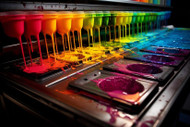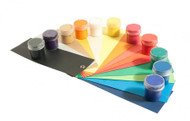5th Apr 2024
Understanding Printer Ink: Types, Formulations, and Uses
In the realm of modern printing, the lifeblood of any printer lies in its ink toners and cartridges. These essential components determine the quality, efficiency, and longevity of your printing endeavors. Whether you're a casual home user or a business professional, understanding the nuances of printer ink is crucial for optimizing your printing experience.
The Basics of Printer Ink
Printer ink is a specialized liquid or powder used in printers to produce text and images on paper. The two primary types of printer ink are liquid ink and toner. Liquid ink is commonly used in inkjet printers, while toner is the choice for laser printers.
Types of Ink Toners
Color laser printers use a combination of four primary color toners—cyan, magenta, yellow, and black—to produce a wide spectrum of colors. These toners work together in varying proportions to create vibrant and accurate color reproductions. For businesses or individuals requiring high-quality color prints, investing in a color laser printer with premium color toners is essential.
Monochrome Toners
Monochrome laser printers, on the other hand, exclusively use black ink toners for printing black and white documents. These printers are ideal for tasks that don't require color, such as text-heavy documents. Monochrome laser printers tend to be more cost-effective, making them a popular choice for offices with substantial black and white printing needs.
Formulations of Ink Toners
The formulation of ink toners is a complex process that involves combining various elements to achieve optimal printing results. The key components include:
- Pigments: Pigments are colorants that provide the actual color to the toner. High-quality pigments ensure vivid and long-lasting prints.
- Polymer Resins: Polymer resins act as the binding agent, holding the toner particles together and facilitating adhesion to the paper.
- Charge Control Agents: These agents help maintain the proper electrical charge on the toner particles, ensuring they adhere to the printer drum during the printing process.
- Wax: Wax is added to the toner formulation to improve the fusing process, ensuring that the toner adheres to the paper effectively.

Choosing the Right Cartridges
While understanding ink toners is crucial, selecting the right cartridges is equally important. Cartridges house the printer ink and play a vital role in ensuring smooth printing operations. Here are some key factors to consider when choosing printer cartridges
- Compatibility: Ensure that the cartridges are compatible with your specific printer model. Using incompatible cartridges can lead to poor print quality and potential damage to the printer.
- OEM vs. Compatible: Original Equipment Manufacturer (OEM) cartridges are produced by the printer manufacturer and are often more expensive. Compatible cartridges are third-party alternatives that are generally more cost-effective but may vary in quality.
- Page Yield: Consider the page yield of the cartridges, which indicates the number of pages the cartridges can print before needing replacement. Higher page yield is usually more cost-effective in the long run.
PRINTERS WITH INKJET (USES: INK)
Inkjet printers use a series of nozzles that spray tiny drops of ink directly on the print surface. The term "responsibility" refers to the act of determining whether or not a person is responsible for his or her own actions. Manufacturers such as Canon and Hewlett Packard use thermal ink heads. The thermal ink head process uses a heating element that vaporizes ink in the nozzle chamber, creating a gas bubble that expands and forces the ink out.
DYE BASED INK
How it works: Colorant in dye ink completely dissolves in superpure deionized water. Various optical compounds are added to increase color vibrancy and saturation. Ethylene glycol keeps the dye in solution with the water and slows evaporation, while solvents help it dry faster once it reaches the printing surface. The ink sprayed from the printer nozzle absorbs into the fibers of the paper. After a long period of time and exposure to direct sunlight, it may show signs of fading or color shifts. Furthermore, because the dye particles are completely liquefied inside the cartridge, prints can still smudge when exposed to humidity or moisture.
SOLVENT BASED INK
How it works: Aqueous inks are great for home or office use, but their commercial applications are limited due to their slow drying time. In order to achieve high-speed production, some printers have turned to solvent-based or UV-curable inks. Solvent inks dry quickly due to evaporation. They are pigment-based, but unlike aqueous formulas, which combine colorant with liquid, they contain volatile organic compounds, or solvents.
Best for use with: Solvent ink produce rich vibrant colors and enable printing on flexible, uncoated vinyl surfaces. Solvent inks are commonly used to create vehicle graphics, billboards, banners, and adhesive decals. They are also waterproof, durable and fade resistant, eliminating the need for special over-coatings. One disadvantage is the requirement for specialized ventilation of the printing area to avoid exposure to hazardous fumes, particularly when using hard solvent inks. Eco-friendly inks are a good alternative. Instead of petroleum, they use soy as a solvent, which allows them to be used in enclosed spaces without the need for specialized ventilation. They are also far easier to recycle than petroleum-based solvents.
The Environmental Impact
As the world becomes increasingly environmentally conscious, the impact of printing on the environment cannot be ignored. Many companies now offer eco-friendly options for both ink toners and cartridges. These options often involve recycling and reusing materials, reducing waste, and utilizing environmentally friendly packaging.
"Printer ink is the silent hero behind every printed page, turning digital ideas into tangible reality. Understanding the intricacies of ink toners and cartridges empowers users to make informed choices, ensuring a seamless and sustainable printing experience."
Conclusion :-
In the dynamic landscape of printing technology, the significance of ink toners and cartridges cannot be overstated. By delving into the types, formulations, and uses of printer ink, users can make informed decisions to meet their specific printing needs. Whether opting for the vibrancy of color toners or the efficiency of monochrome options, understanding the nuances of printer ink ensures that your printed documents consistently meet the highest standards. So, the next time you hit the print button, remember the unsung heroes working diligently within your printer—ink toners and cartridges.












